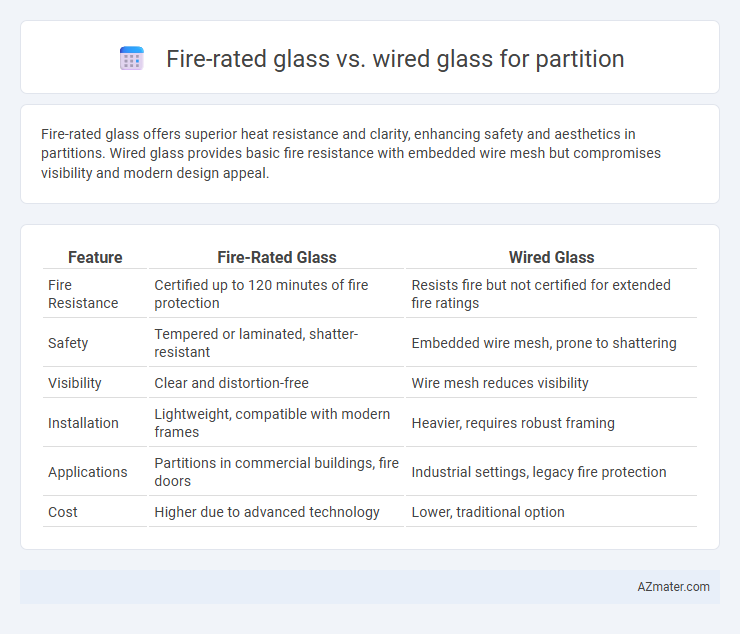Fire-rated glass offers superior heat resistance and clarity, enhancing safety and aesthetics in partitions. Wired glass provides basic fire resistance with embedded wire mesh but compromises visibility and modern design appeal.
Table of Comparison
| Feature | Fire-Rated Glass | Wired Glass |
|---|---|---|
| Fire Resistance | Certified up to 120 minutes of fire protection | Resists fire but not certified for extended fire ratings |
| Safety | Tempered or laminated, shatter-resistant | Embedded wire mesh, prone to shattering |
| Visibility | Clear and distortion-free | Wire mesh reduces visibility |
| Installation | Lightweight, compatible with modern frames | Heavier, requires robust framing |
| Applications | Partitions in commercial buildings, fire doors | Industrial settings, legacy fire protection |
| Cost | Higher due to advanced technology | Lower, traditional option |
Introduction: Understanding Fire-Rated and Wired Glass
Fire-rated glass and wired glass serve critical roles in building safety by providing fire resistance and compartmentalization in partitions. Fire-rated glass offers clear visibility while maintaining a fire-resistance rating ranging from 20 minutes to 120 minutes, effectively slowing fire and smoke spread. Wired glass contains embedded metal mesh for reinforcement, enhancing structural integrity under fire exposure but often compromises clarity and modern safety standards compared to fire-rated alternatives.
Key Differences Between Fire-Rated Glass and Wired Glass
Fire-rated glass offers superior fire resistance by withstanding high temperatures and preventing fire spread, certified to meet stringent fire safety standards, unlike wired glass which contains embedded wire mesh mainly for shatter resistance but not optimized for fire protection. Wired glass is prone to cracking and falling out under intense heat, whereas fire-rated glass remains intact, offering enhanced safety in partitions. Additionally, fire-rated glass provides better clarity and aesthetic appeal compared to the obscured view through wired glass's wire mesh.
Fire Resistance: Performance Comparison
Fire-rated glass provides superior fire resistance compared to wired glass, with the ability to withstand high temperatures and prevent fire spread for up to 120 minutes, meeting stringent UL 9 and NFPA 80 standards. Wired glass, while historically used in fire partitions, offers limited fire protection as the embedded wire mesh may fail under intense heat, allowing flames and smoke to penetrate. Modern fire-rated glass solutions combine tempered or laminated glass with intumescent interlayers, ensuring enhanced structural integrity and compliance with current building codes for effective fire containment.
Safety Considerations: Breakage and Impact Resistance
Fire-rated glass offers superior impact resistance and shattering safety compared to wired glass, as it is designed to withstand high thermal stress while maintaining structural integrity during a fire. Wired glass contains embedded wire mesh, which prevents glass shards from scattering when broken but is more prone to brittle breakage under impact, posing potential safety hazards. For partitions in high-traffic or impact-prone areas, fire-rated glass provides a safer solution by combining fire protection with enhanced durability and resistance to breakage.
Visual Clarity and Aesthetics
Fire-rated glass offers superior visual clarity compared to wired glass, as it lacks the embedded wire mesh that disrupts transparency and aesthetics. Clear fire-rated glass panels provide an unobstructed view, enhancing natural light flow and maintaining modern architectural appeal in partitions. In contrast, wired glass, while providing fire resistance, compromises aesthetic value by adding a grid pattern that reduces transparency and creates a dated or industrial look.
Code Compliance and Certification Requirements
Fire-rated glass must comply with stringent fire-resistance standards such as ASTM E119 or UL 972, ensuring it can withstand intense heat and prevent fire spread for specified durations, typically ranging from 20 to 120 minutes. Wired glass, often meeting older building codes like NFPA 80, offers some fire resistance but generally falls short of modern fire-rated glass certifications due to its limited heat resistance and potential safety hazards upon breakage. Compliance with current codes requires selecting fire-rated glass products with UL or Warnock Hersey certifications, guaranteeing performance in fire partitions and adherence to local building regulations.
Acoustic and Thermal Insulation Properties
Fire-rated glass offers superior acoustic and thermal insulation properties compared to wired glass, making it ideal for partitions in environments requiring noise reduction and energy efficiency. Engineered with multiple layers and specialized interlayers, fire-rated glass minimizes heat transfer and dampens sound transmission effectively. Wired glass, while providing basic fire protection, typically lacks advanced insulation capabilities due to its single pane design with embedded wire mesh, resulting in higher thermal conductivity and less acoustic dampening.
Design Flexibility and Customization
Fire-rated glass offers superior design flexibility and customization compared to wired glass, enabling sleek, modern partitions with clear visibility and diverse thickness options. It supports various finishes, tints, and shapes, accommodating architectural aesthetics without compromising fire safety. Wired glass, while traditional and cost-effective, tends to limit design possibilities due to its embedded wire mesh, resulting in a more industrial look and fewer customization options.
Cost Comparison and Long-Term Value
Fire-rated glass typically incurs higher initial costs compared to wired glass due to advanced manufacturing processes and certified safety standards. Wired glass is generally more affordable upfront but may require frequent replacements or upgrades to meet current fire codes, impacting long-term savings. Investing in fire-rated glass offers better durability, enhanced fire protection, and compliance with stringent regulations, resulting in greater long-term value despite the higher initial expense.
Choosing the Right Glass for Your Partition Needs
Fire-rated glass offers superior heat resistance and maintains structural integrity during fires, making it ideal for enhanced safety in partitions. Wired glass, embedded with a wire mesh, provides basic fire protection but is prone to shattering under impact, limiting its suitability in high-risk areas. Selecting between fire-rated and wired glass depends on your partition's specific fire safety requirements, impact resistance, and regulatory compliance standards.

Infographic: Fire-rated glass vs Wired glass for Partition
 azmater.com
azmater.com